|
|
|
 |
|
This top-of-the-line software is like having your math professor on call 24/7...
|
 |
|
|
|
|
|
|
MULTIPLYING DIVIDING ADDING SUBTRACTING FRACTIONS
square odd integer multiple of 8 plus one triangle number,
slope solving by elimination online calculator,
solving simultaneous equations with excel equation solver
Thank you for visiting our site! You landed on this page because you entered a search term similar to this: multiplying dividing adding subtracting fractions, here's the result:
| |
Intermediate Algebra
Tutorial 33:
Adding and Subtracting
Rational
Expressions
 Learning Objectives Learning Objectives
|
After completing this tutorial, you should be able to:
-
Find the least common denominator of rational expressions.
-
Add and subtract rational expressions.
|
 Introduction Introduction
|
| Do
you ever feel dazed and confused when working with fractions? If
so, you are not alone. This is your lucky day! We have a
whole
other tutorial devoted to rational expressions (fractions). In
this
tutorial we will be looking at adding and subtracting them. If
you
need a review on simplifying, multiplying and dividing rational
expressions,
feel free to go It is
time
to get started with this tutorial. |
 Tutorial Tutorial
|
Adding or Subtracting Rational
Expressions
with Common
Denominators


|
| Step 1: Combine the numerators
together.
Step 2: Put the sum or difference
found in step 1 over
the common denominator.
Step 3: Reduce to lowest terms
as shown in Tutorial
32: Multiplying and Dividing Rational Functions.
|
|
Why do we have to have a common
denominator when
we add or subtract rational expressions?????
|
| Good question. The denominator indicates what
type of fraction
that you have and the numerator is counting up how many of that type
you
have. You can only directly combine fractions that are of the
same
type (have the same denominator). For example if 2 was my
denominator,
I would be counting up how many halves I had. If 3 was my
denominator,
I would be counting up how many thirds I had. But I would not be
able to add a fraction with a denominator of 2 directly with a fraction
that had a denominator of 3 because they are not the same type of
fraction.
I would have to find a common denominator first, which we will cover
after
the next two examples. |
 Example
1: Perform the indicated operation Example
1: Perform the indicated operation  . . |
| Since the two denominators are the same, we can go
right into adding
these two rational expressions. |
| Step 1: Combine the numerators
together
AND
Step 2: Put the sum or difference
found in step 1 over
the common denominator.
|
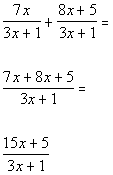 |
*Common denominators
*Combine the numerators
*Write over common denominator
|
| Step 3: Reduce to lowest terms. |
 |
*Factor
out a GCF of 5 in num.
*Divide out the common factor
of 3x
+ 1
|
 Example
2: Perform the indicated operation Example
2: Perform the indicated operation  . . |
| Since the two denominators are the same, we can go
right into subtracting
these two rational expressions. |
| Step 1: Combine the numerators
together
AND
Step 2: Put the sum or difference
found in step 1 over
the common denominator.
|
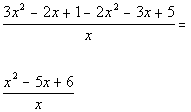 |
*Subtract EVERY term of second
num.
|
| Step 3: Reduce to lowest terms. |
 |
*Factor
the trinomial in num.
*No common factors |
|
Least Common Denominator (LCD)
|
Step 1: Factor all the denominators
| If you need a review on factoring, go to any or
all of the following
tutorials: . |
Step 2: The LCD is the list of all
the DIFFERENT factors
in the denominators raised to the highest power that there is of each
factor.
|
 Example
3: Find the LCD of Example
3: Find the LCD of  . . |
| Step 1: Factor all the denominators. |
| The first denominator "3x"
has two factors,
3 and x.
The second denominator "2" has only one factor, 2.
|
| Step 2: The LCD is the list of all
the DIFFERENT factors
in the denominators raised to the highest power that there is of each
factor. |
| Putting all the different factors together, we get (3)(x)(2)
= 6x for our LCD. |
 Example
4: Find the LCD of Example
4: Find the LCD of  . . |
| Step 1: Factor all the denominators. |
| The first denominator has the following two
factors: |
 |
*Factor
the diff. of two squares |
| The second denominator has the following factor: |
 |
*Factor
the perfect square trinomial |
| Step 2: The LCD is the list of all
the DIFFERENT factors
in the denominators raised to the highest power that there is of each
factor. |
| Putting all the different factors together and using
the highest
exponent, we get the following LCD: |
|
Adding and Subtracting Rational
Expressions Without
a Common Denominator
|
| Step 1: Find the LCD
as shown above
if needed. |
| Step 2: Write equivalent fractions
using the LCD if
needed. |
| If we multiply the numerator and denominator by the
exact same expression
it is the same as multiplying it by the number 1. If that is the
case, we will have equivalent expressions when we do this.
Now the question is WHAT do we multiply top and
bottom by to get
what we want? We need to have the LCD, so you look to see
what
factor(s) are missing from the original denominator that is in the
LCD.
If there are any missing factors than that is what you need to multiply
the numerator AND denominator by.
|
| Step 3: Combine the
rational expressions
as shown above. |
| Step 4: Reduce to lowest terms as
shown in Tutorial
32: Multiplying and Dividing Rational Functions. |
 Example
5: Perform the indicated operation Example
5: Perform the indicated operation  . . |
| Step 1: Find the LCD
as shown above
if needed. |
| The first denominator has the following two
factors: |
 |
*Factor
the trinomial |
| The second denominator has the following factor: |
| Putting all the different factors together and using
the highest
exponent, we get the following LCD: |
| Step 2: Write equivalent
fractions
using the LCD if needed. |
| Since the first rational expression already has
the LCD, we
do not need to change this fraction. |
 |
*Rewriting denominator in
factored form
|
| Rewriting the second expression with the LCD: |
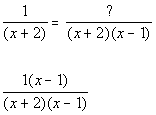 |
*Missing the factor of (x
- 1) in the den.
*Mult. top and bottom by (x
- 1)
|
| Step 3: Combine the
rational expressions
as shown above. |
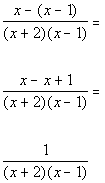 |
*Subtract EVERY term of
( ).
|
| Step 4: Reduce to lowest terms as
shown in Tutorial
32: Multiplying and Dividing Rational Functions. |
| This rational expression cannot be simplified down any
farther.
So, our answer is |
 . . |
|
 Example
6: Perform the indicated operation Example
6: Perform the indicated operation  . . |
| Step 1: Find the LCD
as shown above
if needed. |
| The first denominator has the following factor: |
| The second denominator has the following two
factors: |
 |
*Factor
the sum of cubes |
| Putting all the different factors together and using
the highest
exponent, we get the following LCD: |
| Step 2: Write equivalent
fractions
using the LCD if needed. |
| Rewriting the first expression with the LCD: |
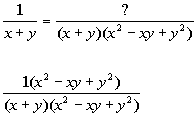 |
*Missing the trinomial factor
in the den.
*Mult. top and bottom by
the trinomial
|
| Since the second rational expression already
has the LCD, we
do not need to change this fraction. |
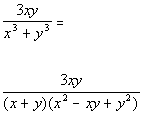 |
*Rewriting denominator in
factored form
|
| Step 3: Combine the
rational expressions
as shown above. |
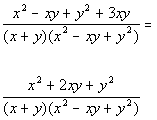 |
*Add the two numerators
together
*Write over the LCD
|
| Step 4: Reduce to lowest terms as
shown in Tutorial
32: Multiplying and Dividing Rational Functions. |
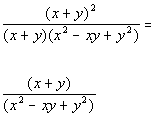 |
*Divide out the common factor
of x
+ y
|
 Example
7: Perform the indicated operation Example
7: Perform the indicated operation  . . |
| Step 1: Find the LCD
as shown above
if needed. |
| The first denominator has the following factor: |
| The second denominator, 7 - x,
looks
like the first denominator except the signs are switched. We can
rewrite this as |
 |
*Factor out a -1 |
| Putting all the different factors together and using
the highest
exponent, we get the following LCD: |
| Note that I did not put the -1 that was in front of the
second denominator's
(x - 7) factor. In step 3, I will put the negative into the
problem
by placing it in the numerator of that second fraction. |
| Step 2: Write equivalent
fractions
using the LCD if needed. |
| Now the two fractions have a common denominator, so we
do not have
to rewrite the rational expressions. |
| Step 3: Combine the
rational expressions
as shown above. |
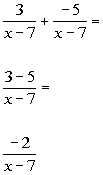 |
*Combine the two num.
*Write over the common den.
|
| Step 4: Reduce to lowest terms as
shown in Tutorial
32: Multiplying and Dividing Rational Functions. |
| This rational expression cannot be simplified down any
farther.
So, our answer is |
 . . |
|
 Example
8: Perform the indicated operation Example
8: Perform the indicated operation  . . |
| Step 1: Find the LCD
as shown above
if needed. |
| The first denominator has the following factor: |
| The second denominator has the following two
factors: |
 |
*Factor
out a GCF of 2 |
| The third denominator has the following two
factors: |
 |
*Factor
out a GCF of a |
| Putting all the different factors together and using
the highest
exponent, we get the following LCD: |
| Step 2: Write equivalent
fractions
using the LCD if needed. |
| Rewriting the first expression with the LCD: |
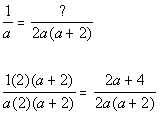 |
*Missing 2(a
+
2) in the den.
*Mult. top and bottom by 2(a
+ 2)
|
| Rewriting the second expression with the LCD: |
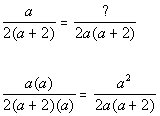 |
*Missing a in
the den.
*Mult. top and bottom by a
|
| Rewriting the third expression with the LCD: |
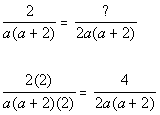 |
*Missing 2 in
the den.
*Mult. top and bottom by 2
|
| Step 3: Combine the
rational expressions
as shown above. |
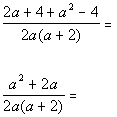 |
*Combine the two num.
*Write over the common den.
|
| Step 4: Reduce to lowest terms as
shown in Tutorial
32: Multiplying and Dividing Rational Functions. |
 |
*Factor
out a GCF of a in the num.
*Divide out the common factors
of a
and
(a + 2)
|
 Practice Problems Practice Problems
|
| These are practice problems to help bring you to the
next level.
It will allow you to check and see if you have an understanding of
these
types of problems. Math works just like
anything
else, if you want to get good at it, then you need to practice
it.
Even the best athletes and musicians had help along the way and lots of
practice, practice, practice, to get good at their sport or instrument.
In fact there is no such thing as too much practice.
To get the most out of these, you should work the
problem out on
your own and then check your answer by clicking on the link for the
answer/discussion
for that problem. At the link you will find the answer
as well as any steps that went into finding that answer.
|
 Practice
Problems 1a - 1c: Practice
Problems 1a - 1c:
Perform the indicated operation.
|
1a. 
(answer/discussion
to 1a) |
1b. 
(answer/discussion
to 1b) |
1c. 
(answer/discussion
to 1c) |
 Need Extra Help on These Topics? Need Extra Help on These Topics?
|
No appropriate web pages could
be found to
help you with the topics on this page.
for
some
more suggestions.
|
All contents
Jan. 8, 2002 |
|
|
|
